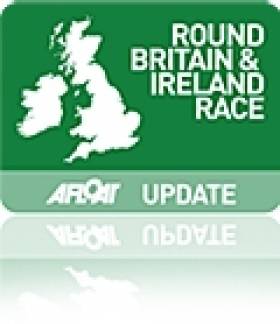Displaying items by tag: John Merricks II
Tonnerre Narrowly Misses Out on Round Britain and Ireland Win
At just before 2 a.m. this morning, The British Keelboat Academy's TP52, John Merricks II crossed the Royal Yacht Squadron Line to finish the Sevenstar Round Britain and Ireland Race. The 14 young crew on board should have taken a bow, but instead they were organising packing up the boat and plan to be back competing in the RORC offshore race to Cherbourg on Friday. Completing this tough and challenging yacht race in a boat that was not constructed for that purpose is some achievement and the John Merricks II crew should be highly regarded for their impeccable boat handling.
"This has been and always was going to be the highlight of our season. It is what we have all been building up for," commented skipper, Luke McCarthy." The crew all performed magnificently and have taken a big step-up in terms of their capabilities and skill levels. Beating up the North Sea was very hard on the crew and the boat, but apart from a few bumps and bruises, the crew and the boat are in good shape. We made a few mistakes which cost us, but the important thing is that we have made leaps and bounds as a crew and we intend to go on from here. I have no doubt that some of the crew will go on to compete at the highest level in offshore racing and I would not be surprised to see some taking part in the Volvo Ocean Race next year."
John Merricks II is second in IRC Super Zero and currently fourth in IRC overall. Crew members Sally Olsen from Devon and Becky Scott from Scotland are the first two girls to complete thisyears race.
Less than two hours later than John Merricks II, Piet Vroon's Ker 46, Tonnerre de Breskens came through the line at pace under spinnaker. In a great show of sportsmanship, John Merricks II cheered Tonnerre de Breskens in. On board were many of their friends and seven of the 11 crew racing Tonnerre de Breskens are under 28 years of age. On the other hand, Piet Vroon is now in his 81st year. Vroon is a previous winner of this race and a veteran of more than 25 Fastnet Races as well as countless RORC offshore races. He has more experience in yacht racing than anyone in the entire fleet. Dockside, Piet Vroon commented:
"Obviously it is disappointing not to win, but we can do nothing about the wind, no-one can. It is has been a fantastic race. I will always remember flying down the west coast of Ireland under spinnaker for a whole day and a whole night. We had our problems, just like everyone else did, but when we had no gas to cook with, we still had food and cold coffee. We didn't go hungry and when the motion of the boat was so bad that we couldn't stand up, we still did our jobs. Everybody has problems, they are not the concern, solving them is. This race is a long one, but once you have spent a few days at sea, a few more doesn't matter so much. I have to say, when we were passing Aberdeen beating up the North Sea, I did think about the nice office I have there and the coffee machine! But, I can only remember retiring from two races; once for my mother's funeral and the second, a Fastnet race when we were dismasted."
Piet Vroon is obviously a man who doesn't give up.
This race has been full of record breakers and the next yacht to finish the Sevenstar Round Britain and Ireland Race should be Tony Lawson's Class 40, Concise skippered by Tom Gall. At 1000 BST, Concise were 114 miles out and expected to finish tomorrow morning. They are currently experiencing very unusual light easterly winds but there will be a big celebration for the young crew. They should be well inside, Michel Kleinjans' Roaring Forty, whose record time of 11 Days 12 hours 26 minutes and 12 seconds has stood for six years.
At 1000 BST, Eike Holst's Andrews 56, Norddeutsche Vermögen Hamburg had 151 miles to go. The German yacht should finish tomorrow assuming that the light winds hold out. As a result of the high-pressure system that is situated over central England, the remainder of the fleet is a substantial distance further back on the race course.
In IRC One, Steven Anderson's First 40.7 Encore, has a substantial lead. In IRC Two, Winsome still hold the advantage over close rival Selene. However Selene has made a move to the west of the rhumb line which will be interesting to see how they fare. It will be a long haul for the boats at the back of the fleet. At 1000 BST, The Army Sailing Association's A 40, British Soldier was off the Tearaght Islands on the stunningly beautiful south west coast of Ireland. British Soldier had 457 miles to go but they obviously haven't lost their sense of humour. As skipper, Tim Hill explains in his blog:
"Life remains on board relatively sane. No major concerns with regards to rations, gas or water, although some interesting combinations are beginning to appear which weren't listed on the original victualling plan. We're out of Tabasco (although Paul, the 1st Mate keeps producing his own reserve which looks decidedly like our missing spare bottle); coffee has been rationed to the over 28s (that's the skipper and 1st mate only) and if we don't get in before Friday, then it's Vesta curry for breakfast, lunch and supper on Sat and Sun - nice!
Jonny Malbon's IMOCA 60 Artemis Ocean Racing is still leading the Sevenstar Round Britain & Ireland overall under IRC.
























































